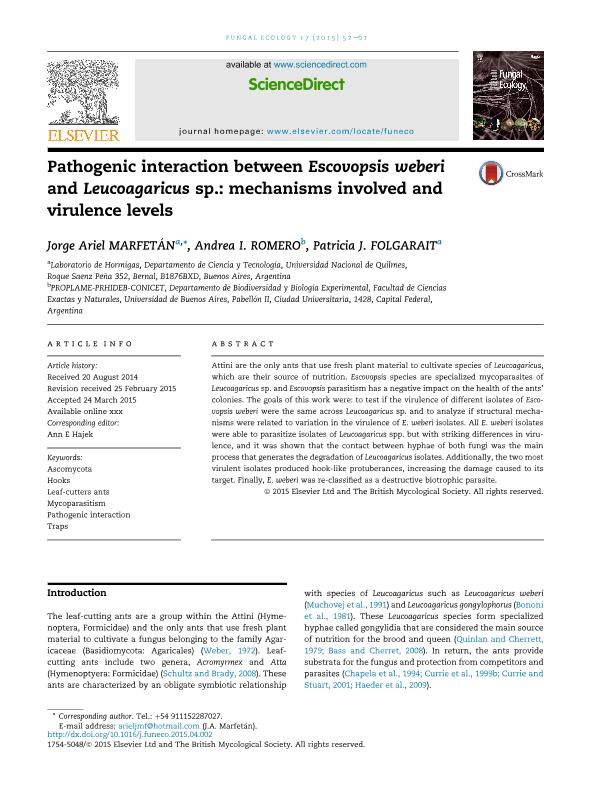Mostrar el registro sencillo del ítem
dc.contributor.author
Marfetan, Jorge Ariel

dc.contributor.author
Romero, Andrea Irene

dc.contributor.author
Folgarait, Patricia Julia

dc.date.available
2018-04-13T22:01:53Z
dc.date.issued
2015-10
dc.identifier.citation
Marfetan, Jorge Ariel; Romero, Andrea Irene; Folgarait, Patricia Julia; Pathogenic interaction between Escovopsis weberi and Leucoagaricus sp.: mechanisms involved and virulence levels; Elsevier; Fungal Ecology; 17; 10-2015; 52-61
dc.identifier.issn
1754-5048
dc.identifier.uri
http://hdl.handle.net/11336/42068
dc.description.abstract
Attini are the only ants that use fresh plant material to cultivate species of Leucoagaricus, which are their source of nutrition. Escovopsis species are specialized mycoparasites of Leucoagaricus sp. and Escovopsis parasitism has a negative impact on the health of the ants' colonies. The goals of this work were: to test if the virulence of different isolates of Escovopsis weberi were the same across Leucoagaricus sp. and to analyze if structural mechanisms were related to variation in the virulence of E. weberi isolates. All E. weberi isolates were able to parasitize isolates of Leucoagaricus spp. but with striking differences in virulence, and it was shown that the contact between hyphae of both fungi was the main process that generates the degradation of Leucoagaricus isolates. Additionally, the two most virulent isolates produced hook-like protuberances, increasing the damage caused to its target. Finally, E. weberi was re-classified as a destructive biotrophic parasite.
dc.format
application/pdf
dc.language.iso
eng
dc.publisher
Elsevier

dc.rights
info:eu-repo/semantics/openAccess
dc.rights.uri
https://creativecommons.org/licenses/by-nc-nd/2.5/ar/
dc.subject
Ascomycota
dc.subject
Mycoparasitism
dc.subject
Pathogenic
dc.subject
Leaf-Cutters Ants
dc.subject.classification
Otras Ciencias Biológicas

dc.subject.classification
Ciencias Biológicas

dc.subject.classification
CIENCIAS NATURALES Y EXACTAS

dc.title
Pathogenic interaction between Escovopsis weberi and Leucoagaricus sp.: mechanisms involved and virulence levels
dc.type
info:eu-repo/semantics/article
dc.type
info:ar-repo/semantics/artículo
dc.type
info:eu-repo/semantics/publishedVersion
dc.date.updated
2018-04-12T14:30:51Z
dc.journal.volume
17
dc.journal.pagination
52-61
dc.journal.pais
Países Bajos

dc.journal.ciudad
Amsterdam
dc.description.fil
Fil: Marfetan, Jorge Ariel. Universidad Nacional de Quilmes. Departamento de Ciencia y Tecnología. Laboratorio de Hormigas; Argentina. Consejo Nacional de Investigaciones Científicas y Técnicas; Argentina
dc.description.fil
Fil: Romero, Andrea Irene. Consejo Nacional de Investigaciones Científicas y Técnicas. Oficina de Coordinación Administrativa Ciudad Universitaria. Instituto de Micología y Botánica. Universidad de Buenos Aires. Facultad de Ciencias Exactas y Naturales. Instituto de Micología y Botánica; Argentina
dc.description.fil
Fil: Folgarait, Patricia Julia. Universidad Nacional de Quilmes. Departamento de Ciencia y Tecnología. Laboratorio de Hormigas; Argentina. Consejo Nacional de Investigaciones Científicas y Técnicas; Argentina
dc.journal.title
Fungal Ecology

dc.relation.alternativeid
info:eu-repo/semantics/altIdentifier/doi/http://dx.doi.org/10.1016/j.funeco.2015.04.002
dc.relation.alternativeid
info:eu-repo/semantics/altIdentifier/url/https://www.sciencedirect.com/science/article/pii/S1754504815000367
Archivos asociados
